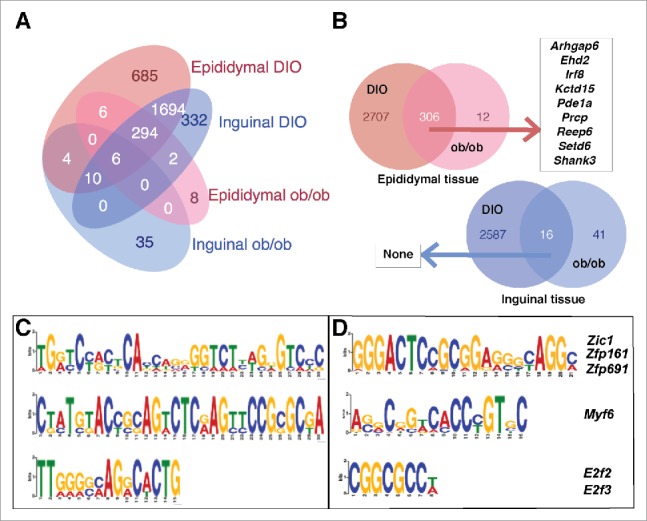Figure 2.

Differentially methylated regions in diet-induced obese and genetically obese ob/ob mice. [A] Genes harboring differentially methylated regions in adipocytes in inguinal and epididymal adipose tissue of diet-induced obese C57BL/6J mice (n = 3) and genetically obese ob/ob mice (n = 4). The highest overlap of 2004 genes was found between inguinal and epididymal adipose tissue from DIO mice (adjusted p-value <0.001). DIO: Diet-induced obese. [B] Venn diagram showing the number of overlapping genes harboring differentially methylated regions in diet-induced obese male C57BL/6J mice (n = 3) and genetically obese male ob/ob mice (n = 4). [A] epididymal adipose tissue and [B] inguinal adipose tissue. Of the 55 overlapping genes with obesity-associated methylation sites as well as altered expression in epididymal adipocytes (adjusted p-value <0.1), 9 genes with abs. log2FC in gene expression in epididymal tissue >1 are enlisted in the figure. DIO: Diet-induced obese. [C] Top 3 motifs predicted in the DMRs based on 16 hypomethylated genes shared by inguinal adipocytes in genetically obese male ob/ob mice (n = 3) and diet-induced obese male C57BL/6J mice (n = 3). [D] Three of the top 7 motifs predicted in the DMRs (see Table S4 for a full list), based on 302 hypomethylated genes shared by epididymal adipocytes in genetically obese male ob/ob mice (n = 3) and diet-induced obese male C57BL/6J mice (n = 3). DIO: Diet-induced obese. Letter size reflects the prevalence of the nucleotide at the position in the motif.
